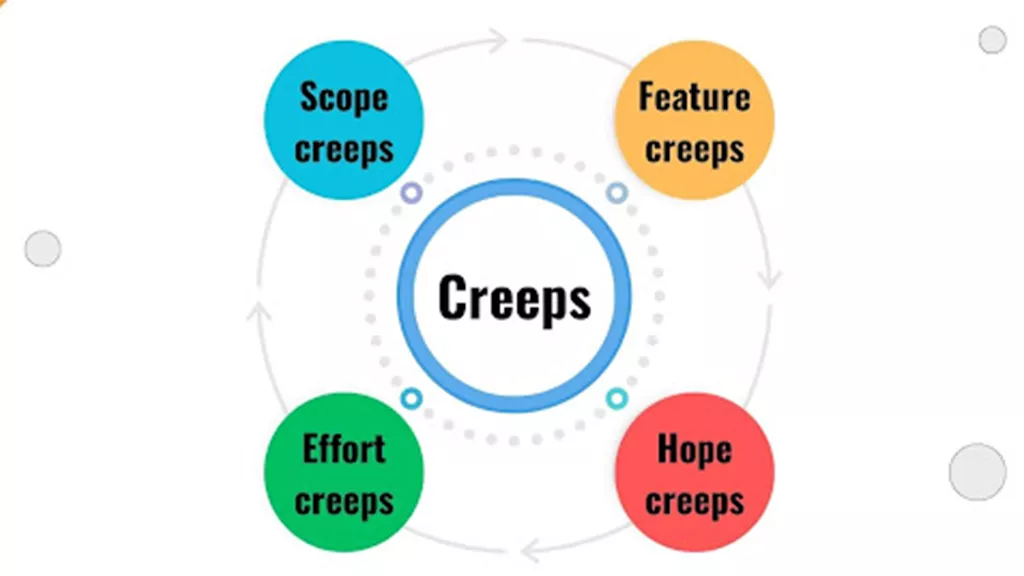
Product management is a dynamic field where a successful product is brought to market by coordinating multiple parts. Despite the great satisfaction this vocation brings, it is not without its challenges and difficulties. In this post, we will describe in detail all the different types of “creeps” that can arise in product management.
Introduction
In software development, “Creep” is a term that can refer to unusual incidents that can cause the project to go out of track or become more difficult to manage. Many of these go undetected until their effect creates a problem.
Product managers handle a wide range of duties, such as working with cross-functional teams and developing product strategy. However, certain unexpected issues, which are termed “creeps,” can sneak into the process, causing disruptions and delays.
Types of Creeps in Product Management
1. Scope Creep:
In simple terms, Scope creep occurs when any change happens in the project that was not in the original plan. This can happen when stakeholders change their requirements or when developers misunderstand the original goals of the project. While some adjustments are expected during the development process, scope creep can lead to increased project complexity, extended timelines, and resource overruns.
2. Feature Creep:
This involves adding too many features, making the product more complicated for users. Sometimes these design requirements are put forward by the stakeholders and even product designers, ultimately increasing user complexity. This is recognized as one of the most persistent product management creeps.
3. Effort Creep:
Effort creep is doing more work without added scope. It is the result of team members putting in effort but not making progress in terms of their workload.
4. Hope Creep:
Hope Creep occurs when a team member falls behind schedule but reports being on track, anticipating they will catch up by the next reporting date.
Impacts Of Creeps
- Creeps impact the project schedule, budget, costs, and resource allocation and might compromise meeting deadlines and achieving goals.
- They extend project development timelines and increase the risk of introducing new bugs.
- They can increase customer dissatisfaction, for instance, in the case of feature creep, where users may find the new features complicated.
- These can negatively impact users’ experiences.
- Creeps can make product management difficult and increase pressure on the project team.
Identifying Creeps Early
Recognizing creeps at their nascent stages is crucial for effective mitigation. Below are some signs we can look for.
- Uncertain Requirements: Project requirements that are inconsistent may be an indication of requirement creep.
- Regular Scope Changes: Scope creep can be identified by an ongoing stream of new features or adjustments to the project’s scope.
- Missed Milestones: Hope creep may be indicated if there is a pattern of missed milestones and falling behind schedule.
- Team Confusion: Effort creep may be at work if the team is unclear about the objectives or tasks of the project.
Mitigating Creeps
1. Scope Creep:
- Verify the Project Scope with the clients & create a clear project schedule that will help manage stakeholders’ expectations and ensure everyone is on the same page.
- Document the project requirements.
2. Feature Creep:
- Focus on delivering user-centered experiences by thoroughly understanding your users.
- Enhance team collaboration to ensure alignment across all ends.
- Ensure the UX team has a fully approved scope of work before proceeding.
- Learn to say “No” to feature requests that fall outside the approved scope.
3. Effort Creep:
Effort creep can occur for a variety of reasons, including poor project management, inadequate communication between stakeholders, and unclear project goals.
- Establish clear project requirements and manage changes carefully.
- Use agile methodologies to break the project into smaller ones and manage the task more efficiently.
4. Hope Creep:
Good management practices are crucial in mitigating this category of creep.
- Regular check-ins with the team.
- Use progress tracking software or any other process.
Conclusion
A proactive approach, clear communication, and a focus on well-defined processes can help keep product management creeps at bay and ensure the successful delivery of innovative and impactful products.
Remember, successful product management involves not just managing the expected but navigating skillfully through the unexpected challenges that may creep into the development process. By addressing these product management creeps head-on, managers can turn potential obstacles into opportunities for growth and improvement.
This page was last edited on 13 June 2024, at 11:41 am
How can we help you?

























